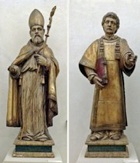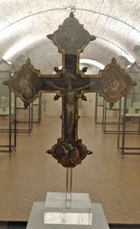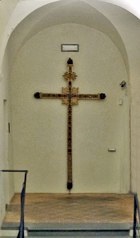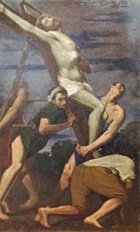

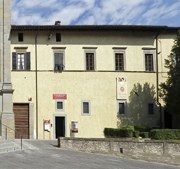
This museum has been established in the ex-Canonica to the right of the Duomo. There was a community of canons associated with the Duomo from an early date, although the earliest surviving part of the ex-Canonica dates to the 13th century.
Treasure of Canoscio (6th century)
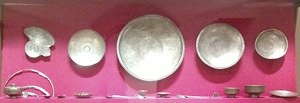
This consists of 25 pieces of magnificent altar furniture that were dug up in 1935 in a field on the Colle di Canoscio, some 12 km south of Città di Castello. See this page in the Museum’s website.
Rule of St Augustine (11th century)
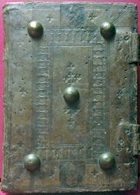
Altar frontal (1144)
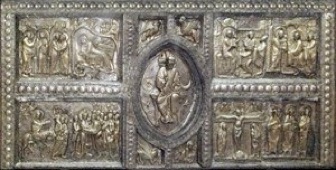
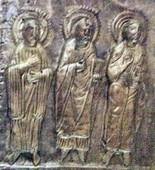
According to tradition, Pope Celestine II (who was a native of the city) presented this silver gilt altar frontal to the Duomo in 1144. The central panel of Christ in Glory and the symbols of the Evangelists is surrounded by panels depicting scenes from the life of Christ:
-
✴the Annunciation, the Visitation and the Nativity (top left);
-
✴the Adoration of the Magi and the Presentation at the Temple (top right);
-
✴the Flight to Egypt and the Capture of Christ (bottom left); and
-
✴the Crucifixion (a very early figure of the iconography of Christus Patiens) and three figures usually identified as SS Floridus, Amantius and Donninus (bottom right).
Imperial privilege (1163)
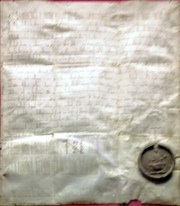
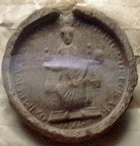
This is one of two privileges granted by the Emperor Frederick I in favour of (respectively) the schismatic Bishop Corbello and his associate, Prior Raniero, the schismatic head of the cathedral canons. It placed them under imperial protection and exempted their possessions from restitution to their exiled predecessors. (It seems that the canonically appointed Bishop Peter was in fact able to return to his post in 1164.)
Inscription (1261)
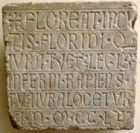
FLOREAT IN CUNCTIS FLORIDI QUI JURA TUETUR
LEGIBUS INFERNI RAPIENS TUA JURA LOCETUR
AD MCCLX7
It promises that those who follow the rights of St Floridus will flourish, while those who turn away from them will face the laws of Hell.
Statutes (14th -15th century)

These statutes of the Compagnia di Sant’ Antonio presumably came from the premises of the confraternity next to the church of Sant’ Antonio Abate.
Panel from a Triptych (1412)
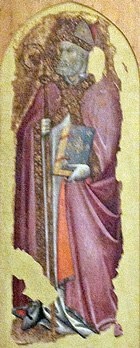
-
✴The central panel of the Madonna and Child, which is attributed to the former artist, is in the Pinacoteca Comunale.
-
✴The third panel, which depicted St Amantius, has been lost.
Madonna and Child with the young St John the Baptist (ca. 1485)
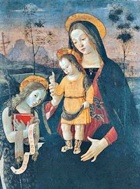
Madonna and Child with Saints (1492)
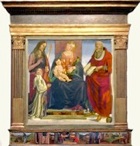
The panel depicts the Madonna and Child with SS John the Baptist and Jerome. The kneeling figure in white is probably the Blessed Giovanni Colombini da Siena, who founded the Gesuati’s convent in Città di Castello in 1365.

The predella panels depict:
-
✴St Jerome removing a thorn from a lion’s paw;
-
✴the Nativity; and
-
✴St Jerome meditating on a Crucifix.
Annunciation (ca. 1504)
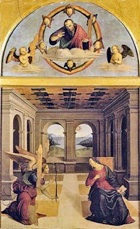
The main panel of this altarpiece, like the upper part of the Ognissanti Altarpiece above, is based on one of the predella panels of Raphael’s Oddi Altarpiece (ca. 1503).
Baptismal Font (ca. 1521)
This font in Room VII, which came from the Pieve di San Crescentino de’ Saddi, is inscribed:
“IULIUS VITELLIUS ELECTUS MDXXI”
([Bishop] Giulio Vitelli, elected in 1521).
Vitelli formally held episcopal office at Città di Castello in 1499 - 1503, although he held on to the post through force of arms until 1505, when Pope Julius II threatened the city with an interdict. He then served with distinction as a mercenary in the papal army, before retiring to Città di Castello in ca. 1520. As noted above, this inscription names him as bishop-elect in 1521. However, circumstances must have intervened to prevent him from taking office: Baldassarre Caetano de Grassi was (at least formally) in post at Città di Castello throughout 1515-35. According to Elvio Ciferri (referenced below, at pp. 234-6), he was “proposto della cattedrale” from 1514 until his death in 1530 and was buried in the Duomo.
Transfiguration (1528-30)
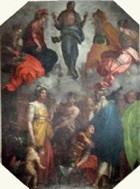
The upper part of the picture, which follows the stipulations of the original contract, depicts the Risen Christ in glory, with the Virgin and SS Anne, Mary Magdalene and Mary of Egypt. This contract added that “below ... several different figures [should be painted] to denote and represent the people". According to Giorgio Vasari, the roof fell in while Rosso was at work on this picture, damaging it and causing him to develop a high fever. He took refuge at Sansepolcro, where, "in a fury he depicted the figure of Christ ascending heavenwards flanked by four worshippers, with below them a group of people including moors, gypsies and some of the strangest beings in the world. All these figures, though perfectly executed, form a composition that was far removed from the expectations of those who had commissioned the picture". It is equally likely that the revolutionary nature of the composition was conditioned by Rosso’s during the sack of Rome.
Epitaph of Alessandro Vitelli (1554)
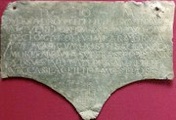
This lead funerary inscription presumably came from the coffin of Alessandro Vitelli. The inscription reads:
To Almighty God, Alessandro Vitelli,
commander of the infantry of Popes Clement VII, Paul III, Julius III,
leader of the armies of Emperor Charles V,
who ... died at the age of 57 years on 15th February 1554....
Placed here by his faithful wife and grieving children
Angels (mid 16th century)

-
✴Behold the promised king of the people; and
-
✴Listen to him therefore and adore him.
SS Floridus and Amantius (16th century)
Panels (16th century)
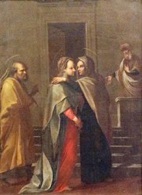
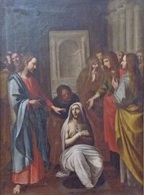
These two panels, which are of unknown provenance and attributed (somewhat tentatively) to Durante Alberti, depict:
-
✴the Visitation; and
-
✴the raising of Lazarus.
Painted Cross (16th century)
Processional Cross (17th century)
Raising of the Cross (17th century)
Saints (17th century)




St Crescentian St Laurence St Floridus St Amantius
The museum displays four panels of saints from the same, unknown provenance:
-
✴two attributed to Giovanni Battista Pacetti, lo Sguazzino:
-
•St Crescentian; and
-
•St Laurence; and
-
✴two attributed to his workshop:
-
•St Floridus; and
-
•St Amantius.
Designs for Frescoes of Cupola of Duomo (1751)
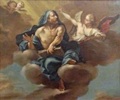
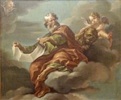
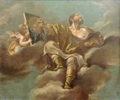
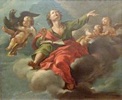
The documented frescoes by Ludovico Mazzanti in the cupola of the Duomo were mostly lost in the earthquake of 1789. However, those of the four Evangelists survive in the pendentives. The designs for the original work are exhibited in museum.
Designs for Frescoes of Transepts of Duomo (1789)
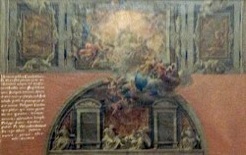
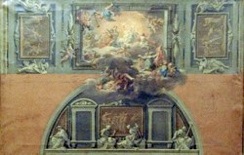
These designs are by Ermenegildo Costantini, who was at work on their execution when he was almost killed in the earthquake of 1789. He fled to Rome, and the work was subsequently completed, essentially to his designs, by Tommaso Conca. The composition of the two designs are as follows:
-
✴The one illustrated here on the left incorporates a piece of writing by Giuseppe Crosti, Costantini’s assistant, who died while at work in the Duomo during the earthquake. The scenes depict:
-
•the triumph of religion, represented by a papal figure in glory;
-
•two small scenes from the lives of (respectively) SS Floridus and Amantius to the sides; and
-
•the death of St Floridus below.
-
✴The second design depicts:
-
•the triumph of Faith, represented by a female figure with a chalice;
-
•small scenes from the lives of (respectively)of the condemnation and martyrdom of St Crescentian; and
-
•a scene below that probably represents the condemnation of the bishop St Albert and his deacon, St Brictius, who were martyred in 711 AD.
Rest on the Flight to Egypt (ca. 1797)
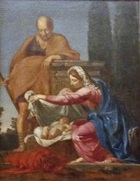
Read more:
E. Ciferri, “Tifernati Illustri: II”, 2001, Città di Castello
C. Vaiani, “La Cattedrale Tifernate e il suo Museo: Guida Storico-Artistica”, (1991) Città di Castello
Return to the Walk I.
Return to Museums of Città di Castello.
